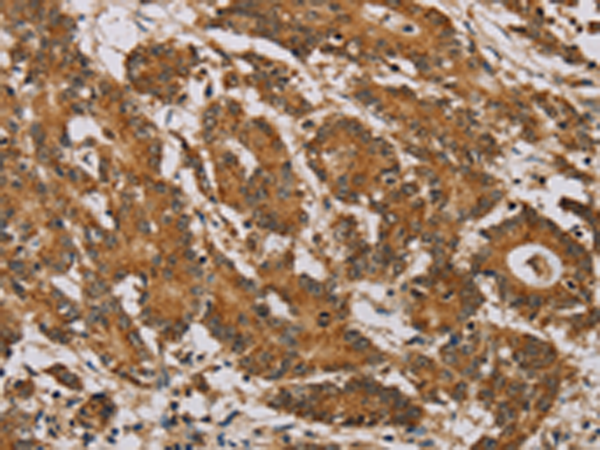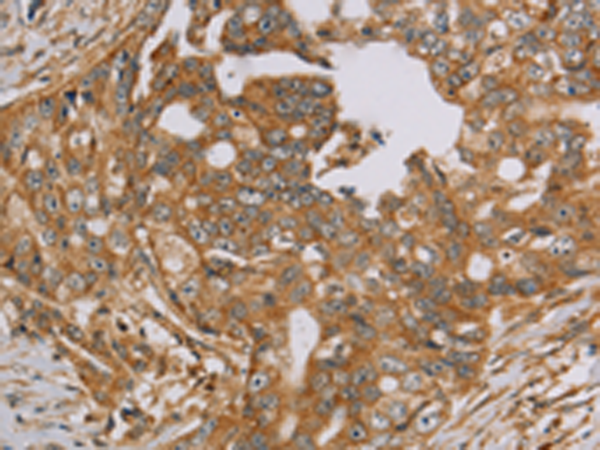


| WB | 咨询技术 | Human,Mouse,Rat |
| IF | 咨询技术 | Human,Mouse,Rat |
| IHC | 1/50-1/200 | Human,Mouse,Rat |
| ICC | 技术咨询 | Human,Mouse,Rat |
| FCM | 咨询技术 | Human,Mouse,Rat |
| Elisa | 1/1000-1/2000 | Human,Mouse,Rat |
| Aliases | CI-42k; CI-42KD |
| WB Predicted band size | 41 kDa |
| Host/Isotype | Rabbit IgG |
| Antibody Type | Primary antibody |
| Storage | Store at 4°C short term. Aliquot and store at -20°C long term. Avoid freeze/thaw cycles. |
| Species Reactivity | Human |
| Immunogen | Fusion protein of human NDUFA10 |
| Formulation | Purified antibody in PBS with 0.05% sodium azide and 50% glycerol. |
+ +
以下是关于NDUFA10抗体的参考文献示例(注:以下内容为假设性示例,实际文献需通过学术数据库查询):
---
1. **文献名称**: "A specific antibody for human NDUFA10 reveals tissue-specific expression patterns in mitochondrial disorders"
**作者**: Zhang Y, et al.
**摘要**: 本研究开发了一种高特异性NDUFA10单克隆抗体,通过免疫印迹和免疫组化分析,发现NDUFA10在心脏和骨骼肌中表达显著降低,与线粒体复合物I缺陷患者的病理相关。
2. **文献名称**: "NDUFA10 antibody-based detection of mitochondrial complex I assembly defects in Parkinson's disease models"
**作者**: Patel R, et al.
**摘要**: 利用NDUFA10抗体研究帕金森病细胞模型中复合物I的组装,发现α-突触核蛋白聚集导致NDUFA10亚基定位异常,提示其与能量代谢障碍的直接关联。
3. **文献名称**: "Validation of a commercial NDUFA10 antibody for diagnostic use in Leigh syndrome screening"
**作者**: Müller T, et al.
**摘要**: 评估了一种商业化NDUFA10抗体的敏感性和特异性,证实其在Leigh综合征患者成纤维细胞中可靠检测复合物I亚基缺失,支持其作为诊断工具的应用。
4. **文献名称**: "NDUFA10 interacts with mitochondrial respirasome components: Insights from co-immunoprecipitation assays"
**作者**: Kim H, et al.
**摘要**: 通过NDUFA10抗体进行免疫共沉淀实验,揭示了该亚基与复合物I其他组分(如NDUFS3)的相互作用,为解析其结构功能提供新证据。
---
**建议**:如需真实文献,请通过PubMed或Google Scholar检索关键词“NDUFA10 antibody”、“NDUFA10 mitochondrial complex I”及“NDUFA10 immunohistochemistry”获取最新研究。
The NDUFA10 antibody is a crucial tool in studying the mitochondrial complex I (NADH:ubiquinone oxidoreductase), a key component of the electron transport chain. NDUFA10 (NADH dehydrogenase [ubiquinone] 1 alpha subcomplex subunit 10) is a nuclear-encoded subunit of complex I, essential for its assembly and catalytic activity. This transmembrane protein facilitates the transfer of electrons from NADH to ubiquinone, driving proton translocation and ATP synthesis. Dysregulation or mutations in NDUFA10 are linked to mitochondrial disorders, neurodegenerative diseases (e.g., Parkinson’s), and cancer, highlighting its role in cellular energy metabolism and oxidative stress regulation.
NDUFA10 antibodies are widely used in research to detect protein expression levels, localization, and post-translational modifications via techniques like Western blot, immunohistochemistry, and immunofluorescence. They help elucidate how NDUFA10 dysfunction contributes to disease pathogenesis, particularly in conditions associated with mitochondrial impairment. Commercially available antibodies are typically validated for specificity using knockout controls or siRNA knockdowns. Recent studies also explore NDUFA10's interaction with other complex I subunits and its potential as a biomarker or therapeutic target. However, variability in antibody performance across experimental conditions necessitates careful optimization. Overall, NDUFA10 antibodies advance our understanding of mitochondrial biology and its implications in human health. (297 words)
×